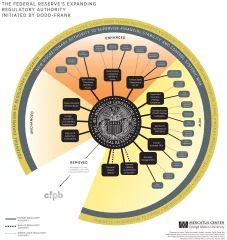- | Financial Markets Financial Markets
- | Federal Testimonies Federal Testimonies
- |
Regulatory Landscape: Burdens on Small Financial Institutions
Testimony Before the House Committee on Small Business
Chairman Schweikert, Ranking Member Clarke, and members of the Subcommittee, thank you for the opportunity to be part of today’s hearing on regulatory burdens on small financial institutions. In financial services, as in every other sector, the United States is not a one-size-fits-all nation. Financial institutions of all different sizes coexist, and customers choose among them based upon their needs. A regulatory environment that is increasingly unwelcoming to small financial institutions may curtail customer choice.
Chairman Schweikert, Ranking Member Clarke, and members of the Subcommittee, thank you for the opportunity to be part of today’s hearing on regulatory burdens on small financial institutions.1
In financial services, as in every other sector, the United States is not a one-size-fits-all nation. Financial institutions of all different sizes coexist, and customers choose among them based upon their needs. A regulatory environment that is increasingly unwelcoming to small financial institutions may curtail customer choice.
Increasingly burdensome regulation is not the only challenge facing small banks and credit unions. They are also confronting slow economic growth, declining populations in rural areas, the increasing technological sophistication of banking, the sustained low–interest-rate environment, competition from new types of financial services providers, and difficult capital markets. Small financial institutions can adapt and excel in the face of such challenges, but not if regulation stands in the way and absorbs resources and managerial attention that would otherwise be devoted to dealing with them.
Today I will briefly discuss the importance of small financial institutions and then talk about three ways in which regulation or regulators are threatening their future prospects. First, the regulatory framework accommodates large financial institutions better than it does small ones. Second, the increased regulatory and compliance burden is felt most heavily by the smallest financial institutions. Finally, regulators’ lackluster commitment to fundamental administrative process protections takes a particular toll on small financial institutions.
The Importance of Small Institutions
With one-fifth of one percent of the banking industry controlling two-thirds of its assets,2 it is easy to forget the important role that the remaining financial institutions—most of which are small—play. Many have served their communities for decades and continue to serve the financial needs of millions of retail customers and small businesses. Community banks are particularly important in rural areas. The FDIC reported that community banks serve “more than 1,200 US counties (out of a total of 3,238), encompassing 16.3 million people, who would have limited physical access to mainstream banking services without the presence of community banks.” 3 They are also key providers of small business loans. By one measure, “$1 out of every $2 lent to small businesses comes from community banks.” 4 Federal Reserve Governor Jerome Powell has noted that “as auto, mortgage, and credit card loans have become increasingly standardized, community banks have had to focus to a greater extent on small business and commercial real estate lending—products where community banks’ advantages in forming relationships with local borrowers are still important.” 5 Credit unions are also an increasingly important source of small business loans.6 More generally, credit-union lending expanded by thirteen percent between the end of 2007 and the end of 2012.7
Community-based financial institutions are able to distinguish themselves from larger competitors by developing firsthand knowledge about their customers. This enables them to provide personalized service and meet the needs of the local residents and businesses in ways that a larger, nonlocal bank, which does not know the unique characteristics of the community, cannot. The Government Accountability Office explained:
Despite the decline in their number, community banks and credit unions have maintained their relationship-banking model, relying on their relationships with customers and local knowledge to make loans. Such institutions can use their relationship-based information to make loans to small businesses and other borrowers that larger banks may not make because of their general reliance on more automated processes.8
Federal Reserve Governor Elizabeth Duke likewise cited the following “natural advantages” of community banks: “deep community ties, daily interaction between senior managers of banks and their customers, and the dexterity to customize financial solutions.” 9


